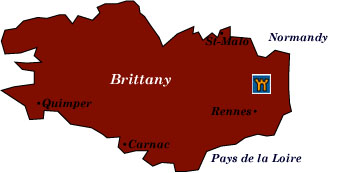Castle Hotels of Brittany
Haven’t decided on a hotel yet? You can look at other available hotels in the Brittany region with Booking.com.
Brittany’s Celtic heritage, wealth of mysterious megalithic monuments, and breathtaking 700 miles of coastline offer a mystique and wildness quite unlike the rest of France. Defined by the sea, timeless seaside resorts, hidden coves, and mist-enshrouded islands enchant all who come to explore.
Some great reasons to visit
![]() St-Malo French privateers and wealthy merchants once lived in the fine houses you see within the 12th-century city walls of St. Malo. Beautifully restored following the bombardments of WWII, a stroll will lead you to the Cathédral St-Vincent (look for the mosaic plaque that commemorates the blessing Jacques Cartier received before his expedition to Canada in 1535. The Château de St-Malo, built by the dukes of Brittany in the 15th and 16th centuries, houses the Musée du Château, which has permanent exhibitions highlighting the town’s role in WWII and the fishing industry.
St-Malo French privateers and wealthy merchants once lived in the fine houses you see within the 12th-century city walls of St. Malo. Beautifully restored following the bombardments of WWII, a stroll will lead you to the Cathédral St-Vincent (look for the mosaic plaque that commemorates the blessing Jacques Cartier received before his expedition to Canada in 1535. The Château de St-Malo, built by the dukes of Brittany in the 15th and 16th centuries, houses the Musée du Château, which has permanent exhibitions highlighting the town’s role in WWII and the fishing industry.
Just across the water, Dinard is the quintessential seaside resort that looks like it emerged from out of a painting. British aristocracy used to favor the hotels and casino here at the end of the 19th century. Blue-and-white seaside tents are sprinkled down the beach, while Belle Époque mansions on the hills above look out to sea.
![]() Quimper History began here in the mists of legend. Today you will find a delightful, flower-filled town of cobbled streets dominated by the 13th-century Gothic Cathédrale St-Corentin. The Musée des Beaux-Arts houses an outstanding collection of art from the Pont-Aven school. Many people travel to Quimper to buy its distinctive faience pottery, a local industry since the 17th century.
Quimper History began here in the mists of legend. Today you will find a delightful, flower-filled town of cobbled streets dominated by the 13th-century Gothic Cathédrale St-Corentin. The Musée des Beaux-Arts houses an outstanding collection of art from the Pont-Aven school. Many people travel to Quimper to buy its distinctive faience pottery, a local industry since the 17th century.
![]() Dinan Untouched by war, Dinan is still a perfectly preserved medieval village—one of the best in Brittany. Half-timbered houses built on stilts overlooking narrow cobblestone streets once saw the ducs de Bretagne pass by, and no doubt local hero, the 14th-century warrior Bertrand du Guesclin walked on the town’s surrounding ramparts.
Dinan Untouched by war, Dinan is still a perfectly preserved medieval village—one of the best in Brittany. Half-timbered houses built on stilts overlooking narrow cobblestone streets once saw the ducs de Bretagne pass by, and no doubt local hero, the 14th-century warrior Bertrand du Guesclin walked on the town’s surrounding ramparts.
![]() Concarneau Just southeast of Quimper and unspoiled by the tourist mass, this port town used to capture the imagination of painters who would come to replicate images of the fishing fleet. Of course, a 14th-century walled town built on an island in the middle of the harbor (accessible by a footbridge) is a great attraction for lovers of the medieval era.
Concarneau Just southeast of Quimper and unspoiled by the tourist mass, this port town used to capture the imagination of painters who would come to replicate images of the fishing fleet. Of course, a 14th-century walled town built on an island in the middle of the harbor (accessible by a footbridge) is a great attraction for lovers of the medieval era.
![]() Carnac Vestiges of Neolithic civilization—menhirs, cairns, and dolmens can be found throughout Brittany. One of the most prehistoric sites in Europe, the area around Carnac can boast of some 3000 upright stones even older than those of Stonehenge.
Carnac Vestiges of Neolithic civilization—menhirs, cairns, and dolmens can be found throughout Brittany. One of the most prehistoric sites in Europe, the area around Carnac can boast of some 3000 upright stones even older than those of Stonehenge.
![]() Josselin One of the more mighty châteaux of Brittany is the 15th-century Château de Josselin. The Rohan family has presided over the château for nearly 500 years.
Josselin One of the more mighty châteaux of Brittany is the 15th-century Château de Josselin. The Rohan family has presided over the château for nearly 500 years.
![]() Fougères is a dramatic, moated, 11th-century fortress on the border between Brittany and the rest of France. The thirteen towers were added in the 14th and 15th centuries.
Fougères is a dramatic, moated, 11th-century fortress on the border between Brittany and the rest of France. The thirteen towers were added in the 14th and 15th centuries.


